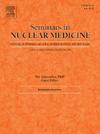FAPI PET/CT在胆管癌和胰腺癌诊断中的价值
IF 5.9
2区 医学
Q1 RADIOLOGY, NUCLEAR MEDICINE & MEDICAL IMAGING
引用次数: 0
摘要
迄今为止,对比增强CT (ceCT),磁共振成像(MRI),以及在某些情况下,18f -氟脱氧葡萄糖正电子发射断层扫描/计算机断层扫描(18F-FDG PET/CT)是目前胰腺癌和胆管癌分期的标准成像方式。成纤维细胞活化蛋白(FAP)作为一种有前景的分子成像靶点,特别是在具有明显的结缔组织增生反应的肿瘤中,如胰腺癌和胆管癌,已引起人们的兴趣。放射标记FAP抑制剂(fapi)可以通过PET/CT实现肿瘤的无创可视化。最近的研究表明,与ceCT和18F-FDG PET/CT相比,FAPI PET/CT在胆管癌和胰腺癌中检测原发肿瘤、淋巴结累及和远处转移,特别是由于生理背景摄取低而导致的肝转移,具有更高的灵敏度。此外,FAPI PET/CT已显示影响TNM分期并随后改变治疗决策。除了分期,早期证据表明FAPI PET/CT在肿瘤分级、治疗反应评估和生存结果方面的预后潜力,尽管数据仍然有限。另一方面,FAPI PET/CT存在局限性,特别是在纤维化和炎症过程(如肝硬化、胰腺炎或原发性硬化性胆管炎)的情况下,这可能导致假阳性结果。本综述总结了FAPI PET/CT在胰腺癌和胆管癌中的临床证据,重点讨论了FAPI PET/CT在胰腺癌和胆管癌中的诊断表现、预后相关性、治疗意义和潜在缺陷。本文章由计算机程序翻译,如有差异,请以英文原文为准。
The Value of FAPI PET/CT in Cholangiocarcinoma and Pancreatic Cancer: An Update
To date, contrast-enhanced CT (ceCT), magnetic resonance imaging (MRI), and, in selected cases, 18F-fluorodeoxyglucose positron emission tomography/computed tomography (18F-FDG PET/CT) are the current standard imaging modalities for staging of pancreatic cancer and cholangiocarcinoma. Fibroblast activation protein alpha (FAP) has gained interest as a promising molecular imaging target, particularly in tumors with a pronounced desmoplastic reaction such as pancreatic cancer and cholangiocarcinoma. Radiolabeled FAP inhibitors (FAPIs) enable noninvasive visualization of cancer using PET/CT. Recent studies have demonstrated that FAPI PET/CT provides superior sensitivity compared to ceCT and 18F-FDG PET/CT in cholangiocarcinoma and pancreatic cancer for detecting primary tumors, lymph node involvement, and distant metastases, particularly in hepatic metastases due to low physiological background uptake. Furthermore, FAPI PET/CT has been shown to affect TNM staging and subsequently alter treatment-decision making. Beyond staging, early evidence suggests a prognostic potential of FAPI PET/CT in tumor grading, therapy response assessment, and survival outcomes, although data remain limited. On the other hand, FAPI PET/CT comes with limitations, particularly in the context of fibrotic and inflammatory processes such as liver cirrhosis, pancreatitis, or primary sclerosing cholangitis, which may result in false-positive findings. This review summarizes the current clinical evidence for FAPI PET/CT in pancreatic cancer and cholangiocarcinoma, with a focus on diagnostic performance, prognostic relevance, therapeutic implications, and potential pitfalls.
求助全文
通过发布文献求助,成功后即可免费获取论文全文。
去求助
来源期刊

Seminars in nuclear medicine
医学-核医学
CiteScore
9.80
自引率
6.10%
发文量
86
审稿时长
14 days
期刊介绍:
Seminars in Nuclear Medicine is the leading review journal in nuclear medicine. Each issue brings you expert reviews and commentary on a single topic as selected by the Editors. The journal contains extensive coverage of the field of nuclear medicine, including PET, SPECT, and other molecular imaging studies, and related imaging studies. Full-color illustrations are used throughout to highlight important findings. Seminars is included in PubMed/Medline, Thomson/ISI, and other major scientific indexes.
 求助内容:
求助内容: 应助结果提醒方式:
应助结果提醒方式:


